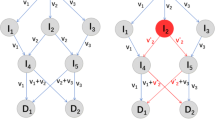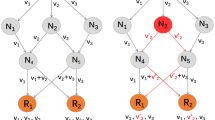Abstract
It has been forty years since the TCP/IP protocol blueprint, which is the core of the modern worldwide Internet, was published. Over this long period, technology has made rapid progress. These advancements are slowly putting pressure and new demands on the underlying network architecture design. Therefore, there was a need for innovations that could handle the increasing demands of new technologies like IoT while ensuring secrecy and privacy. It is how named data networking (NDN) came into the picture. NDN enables robust data distribution with interest-based content retrieval and a leave-copy-everywhere caching policy. Even though NDN has surfaced as a future envisioned and decisive machinery for data distribution in IoT, it suffers from new data security challenges like content poisoning attacks. In this attack, an attacker attempts to introduce poisoned content with an invalid signature into the network. Given the circumstances, there is a need for a cost-effective signature scheme, requiring inexpensive computing resources and fast when implemented. An identity-based signature scheme (IBS) is the natural choice to address this problem. Herein, we present an IBS, namely Mul-IBS relying on multivariate public key cryptography (MPKC), which leads the race among the post-quantum cryptography contenders. A 5-pass identification scheme accompanying a safe and secure signature scheme based on MPKC works as key ingredients of our design. Our Mul-IBS attains optimal master public key size, master secret key size, and user’s secret key size in the context of multivariate identity-based signatures. The proposed scheme Mul-IBS is proven to be secure in the model, existential unforgeability under chosen-message and chosen identity attack (uf-cma), contingent upon the fact that Multivariate Quadratic (MQ) problem is NP-hard. The proposed design Mul-IBS can be utilized as a crucial cryptographic building block to build a robust and resilient IoT-based NDN architecture.




Similar content being viewed by others
Data availability
The data and material are entirely available.
References
Bernstein, D.J.: Introduction to post-quantum cryptography. In: Post-quantum Cryptography, pp. 1–14. Springer (2009)
Beullens, W.: Breaking rainbow takes a weekend on a laptop. In: Cryptology ePrint Archive (2022)
Bogdanov, A., Eisenbarth, T., Rupp, A., Wolf, C.: Time-area optimized public-key engines: \(\cal{MQ}\)-cryptosystems as replacement for elliptic curves?. In: International Workshop on Cryptographic Hardware and Embedded Systems, pp. 45–61 (2008)
Chen, A.I.-T., Chen, Chen, M.-S., Cheng, T. R., Ding, C.M., Kuo, J., Eric L.-H., Lee F.Y., Yang B.-Y.: SSE implementation of multivariate PKCs on modern x86 CPUs. In: International Workshop on Cryptographic Hardware and Embedded Systems, pp. 33–48 (2009)
Chen, J., Ling, J., Ning, J., Ding, Jintai: Identity-based signature schemes for multivariate public key cryptosystems. Comput. J. 62(8), 1132–1147 (2019)
Chen, M.S., Hülsing, A., Rijneveld, J., Samardjiska, S., Schwabe, Peter: From 5-pass mq-based identification to mq-based signatures. IACR Cryptol. Arch. 2016, 708 (2016)
Ding, J., Petzoldt, A., Schmidt, D.S.: Multivariate Public Key Cryptosystems, vol. 80. Springer, Cham (2020)
Ding, J., Schmidt, D.: Rainbow, a new multivariable polynomial signature scheme. In: International Conference on Applied Cryptography and Network Security, pp. 164–175. Springer (2005)
Garey, M. R., Johnson, D.S.: Computers and intractability, vol 174. Freeman San Francisco (1979)
Goldwasser, S., Micali, S., Rivest, R.L.: A digital signature scheme secure against adaptive chosen-message attacks. SIAM J. Comput. 17(2), 281–308 (1988)
Van, J., Smetters D. K., Thornton, J. D., Plass, M. F., Briggs, N. H., Braynard, R. L.: Networking named content. In: Proceedings of the 5th international conference on Emerging networking experiments and technologies, pp. 1–12 (2009)
Kipnis, A., Patarin, J., Goubin, L.: Unbalanced oil and vinegar signature schemes. In: International Conference on the Theory and Applications of Cryptographic Techniques, pp. 206–222. Springer (1999)
Koblitz, Neal: Elliptic curve cryptosystems. Math. Comput. 48(177), 203–209 (1987)
Kravitz, D. W.: Digital signature algorithm, July 27. US Patent 5,231,668 (1993)
Van Luyen, Le., et al.: An improved identity-based multivariate signature scheme based on rainbow. Cryptography 3(1), 8 (2019)
Matsumoto, T., Imai, H.: Public quadratic polynomial-tuples for efficient signature-verification and message-encryption. In: Workshop on the Theory and Application of of Cryptographic Techniques, pp. 419–453. Springer (1988)
Patarin, J.: Hidden fields equations (HFE) and isomorphisms of polynomials (IP): two new families of asymmetric algorithms. In: International Conference on the Theory and Applications of Cryptographic Techniques, pp. 33–48. Springer (1996)
Patarin, J., Goubin, L.: Trapdoor one-way permutations and multivariate polynomials. In: International Conference on Information and Communications Security, pp. 356–368. Springer (1997)
Paterson, K. G., Schuldt J.C.N.: Efficient identity-based signatures secure in the standard model. In: Australasian Conference on Information Security and Privacy, pp. 207–222. Springer (2006)
Petzoldt, A.: Selecting and reducing key sizes for multivariate cryptography. PhD thesis, tuprints (2013)
Petzoldt, A., Chen, M.-S., Yang, B.-Y., Tao, C., Ding, J.: Design principles for HFEV-based multivariate signature schemes. In: International Conference on the Theory and Application of Cryptology and Information Security, pp. 311–334. Springer (2015)
Postel, J.B., Sunshine, C.A., Cohen, D.: The arpa internet protocol. Comput. Netw. 5(4), 261–271 (1981)
Rivest, R.L., Shamir, A., Adleman, L.: A method for obtaining digital signatures and public-key cryptosystems. Commun. ACM 21(2), 120–126 (1978)
Sakumoto, K., Shirai, T., Hiwatari, H.: On provable security of UOV and HFE signature schemes against chosen-message attack. In: International Workshop on Post-Quantum Cryptography, pp. 68–82. Springer (2011)
Sakumoto, K., Shirai, T., Hiwatari, H.: Public-key identification schemes based on multivariate quadratic polynomials. In: Annual Cryptology Conference, pp. 706–723. Springer (2011)
Shamir, A.: Identity-based cryptosystems and signature schemes. In: Workshop on the theory and application of cryptographic techniques, pp. 47–53. Springer (1984)
Shen, W., Tang, S., Xu, L.: Ibuov, a provably secure identity-based UOV signature scheme. In: 2013 IEEE 16th International Conference on Computational Science and Engineering, pp. 388–395. IEEE (2013)
Shor, P.W.: Polynomial-time algorithms for prime factorization and discrete logarithms on a quantum computer. SIAM Rev. 41(2), 303–332 (1999)
Tao, C., Diene, A., Tang, S., Ding, J.: Simple matrix scheme for encryption. In: International Workshop on Post-Quantum Cryptography, pp. 231–242. Springer (2013)
Zhang, L., Afanasyev, A., Burke, J., Jacobson, Van, K.C.C., Crowley, P., Christos P., Lan W., and Beichuan Z.: Named data networking. ACM SIGCOMM Comput. Commun. Rev., 44(3):66–73, (2014)
Acknowledgements
The authors address their sincere thanks to Associate Editor and the reviewers for their valuable comments that improved the quality of this paper.
Author information
Authors and Affiliations
Contributions
All the authors have contributed to designing the study, analyzing, interpreting data, writing the manuscript, and performed the results.
Corresponding author
Ethics declarations
Conflict of interest
The authors declare having no conflict of interest and confirm their consent regarding the participation and their ethics approval.
Human and animal rights
Besides, their article involves only human participants (the authors of this paper) but no animals.
Additional information
Publisher's Note
Springer Nature remains neutral with regard to jurisdictional claims in published maps and institutional affiliations.
Rights and permissions
Springer Nature or its licensor (e.g. a society or other partner) holds exclusive rights to this article under a publishing agreement with the author(s) or other rightsholder(s); author self-archiving of the accepted manuscript version of this article is solely governed by the terms of such publishing agreement and applicable law.
About this article
Cite this article
Debnath, S.K., Mesnager, S., Srivastava, V. et al. Mul-IBS: a multivariate identity-based signature scheme compatible with IoT-based NDN architecture. J Cryptogr Eng 13, 187–199 (2023). https://doi.org/10.1007/s13389-022-00308-8
Received:
Accepted:
Published:
Issue Date:
DOI: https://doi.org/10.1007/s13389-022-00308-8




